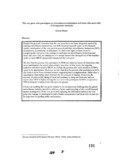The very poor who participate in microfinance institutions and those who never did: a comparative analysis
Citation
Matin, I. (2004). The very poor who participate in microfinance institutions and those who never did: a comparative analysis. Research Reports (2004): Economic Studies, Vol - XXI, 131–140.Abstract
Despite the general consensus that the very poor have not been adequately reached by existing microfinance institutions, very little focussed research exists on the financial market participation of the very poor in general and their microfinance institutions (MFI) participation, in particular. In this paper, we shed some light on these issues by comparing the very poor who manage to participate in microfinance institutions and those who never did, by making use of a unique dataset that emerged out of the baseline study of a new BRAC programme targeted at the very poor. We find that the poorest who participate in MFIs are relatively better off than those who never participated, the causal relationship is not clear. In that sense, the targeting exclusion condition used by BRAC to exclude the poorest who were members of MFIs seems to be appropriate. However, we also find that the poorest who participate in MFIs also borrow more from informal sources suggesting that a complementary, rather than a substitution relationship exists between the two sources of finance. Moreover, the intensity of microcredit taking is lower and tendency to drop out from one and not rejoin other MFIs is higher among the very poor who participate in MFIs compared to MFI participants coming from other poverty grou ps. Given that reaching the very poor remains to be an important challenge that the global microfinance industry intends to address, a better understanding of the overall financial market participation of the very poor and exploring the differences between the very poor who manage to participate in microfinance programmes and those who do not can be important for guiding policy and practice.

